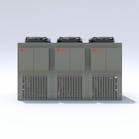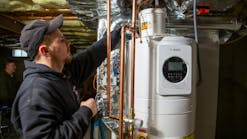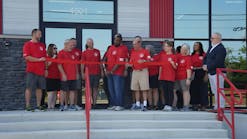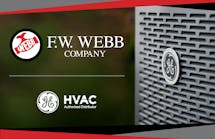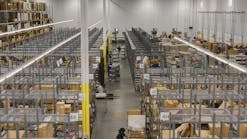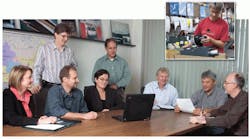When the weather last year turned unseasonably cold, and temperatures plunged below 40 degrees in the southern United States, the owners of many unheated manufacturing facilities and factories turned to Canada for warmth. They needed the infrared heating solutions of Superior Radiant Products Ltd. to keep their employees warm and their heating bills as manageable as possible.
"All of a sudden, our switchboard lit up," recalls Tom Delp, national sales manager for Superior Radiant Products, of the cold snap that left many employers scrambling to heat their facilities so their employees could stay on the job. "Our high-efficiency, gas-fired infrared heaters were an easy solution so they could put heaters in those spaces and put the workers back in place."
That Superior Radiant Products received so many calls demonstrated two things: Infrared heating has become an accepted and well-established choice for heat, and Superior Radiant Products is fast becoming the go-to company for heating solutions.
Kevin Merritt, president of Superior Radiant Products, founded the company in 1995 with two other partners. The idea behind Superior Radiant was to put technology into the forefront of its infrared heating products. Its engineers developed a reflector design that they found to be the most efficient method for tube heat. Today, Superior Radiant's 10-sided reflector is the only one of its kind among infrared heating manufacturers. Such a multifaceted configuration reflects virtually 100 percent of the infrared energy out and away from the emitter tubes and spreads the heat evenly wherever the customer needs it. This means greater fuel savings and enhanced comfort.
With this technology, Superior Radiant built a basic product line of infrared heaters and has expanded that line over the years to meet the needs of a wider customer base, including residential, commercial, industrial and agricultural as well as sports facilities and the hospitality industry. Today, Superior Radiant boasts a broad range of products, from the basic tube heater to various configurations that are suitable in any kind of environment.
The future of heating is in infrared radiant products, say Merritt and Delp, emphasizing that Superior Radiant invests heavily in research and development. "We want to be at the forefront of this," Delp says. This year, Superior Radiant entered into a strategic alliance with a prominent German company, GoGaS Goch GmbH, to introduce European heating technology with reduced emissions to the North American market. "We're going to get the best of both worlds," Merritt says. "Both companies are very excited about the collaboration in research and development and the opportunities this brings worldwide with future harmonization of product lines."
With so many items that are scalable to different sizes, Superior Radiant products are found in a wide variety of applications — from ice arenas and gymnasiums to airplane hangars and cargo facilities. Car washes are also a popular niche for Superior Radiant heaters because the heat can be directed to keep floors dry and prevent ice from building up on the brushes during winter.
From its inception, Superior Radiant also recognized that energy efficiency would be critical in the design and marketing of its products. Even before "energy efficiency" and "green" became buzzwords that manufacturers in virtually every industry have since latched onto, Superior Radiant was already there. So much so that Superior Radiant has always built its burners with housings that are painted the color green. "Fifteen years ago, we decided that we wanted the boxes to be green so our products could be seen as green," Merritt says. "And that was before the 'green' movement."
Page 2 of 3
Now that energy efficiency is on the minds of everyone who has to heat or cool a building or home, infrared heating is drawing increased attention, especially in the U.S. market. Case studies and testimonials have always been powerful tools to promote Superior Radiant's comfort, energy efficiency and cost savings, but the company may soon have a new proof point in the form of hard numbers that will show the energy efficiency of infrared heating products.
In Europe, 80 percent of all applications use some sort of infrared heating device, with standards in place that show the efficiency of infrared heating products. Merritt and representatives from other infrared heating product companies, along with industry associations, are now trying to create similar standards in North America. Absent any data to measure the energy efficiency of infrared heating, "we've never had anything that really shows how efficient this is," Merritt says. Once standards are in place, "our efficiency will finally get noticed."
ASHRAE standards already account for the energy efficiency of infrared heating, notes Delp, allowing a 15 percent to 20 percent reduction of the heat load when infrared heat is calculated. Superior Radiant uses this ASHRAE standard, which has been in place since 1987, as a way to show distributors and their customers about the energy savings that infrared heating brings. "What we're seeing in the U.S. through our wholesalers is that they have a better understanding of infrared," Delp says. "What we're being asked by wholesalers is 'why?' Just give me a compelling reason to sell and stock it."
Education is a big part of the job for Merritt, Delp and everyone at Superior Radiant. Part of their work is to demystify infrared heating and show customers that it is not that complicated to install and service. While other infrared heating manufacturers have sold through specialized distribution, Superior Radiant has made it a point to sell through the distributor that carries a broader line of HVACR products and, thus, reach a broader swath of customers.
The company is also working closely with HARDI leadership and members to educate and inform them. In fact, Delp says most of the wholesalers that they have worked with are HARDI members. "The HARDI membership is tremendous," he says. "HARDI comprises the best of the best. I am absolutely convinced of that." Superior Radiant has been a HARDI member since the company's decision to pursue the wholesale channel in 2004, and they are always represented at HARDI annual conference as well as regional meetings. Its independent reps are also HARDI members.
Installing and servicing infrared heating certainly does require training, Merritt says, but Superior Radiant is continuing its training efforts and is considering HARDI's online training as a way to push it to distributor branches. A training DVD takes contractors through the installation process as well as the fundamentals of infrared. Superior Radiant's independent representatives also train engineers as well as their distributor customers. "We have all levels of capabilities — marketing, product training, engineering — to align the right training with the right groups," Delp says. "It all depends on their needs."
Merritt and Delp are finding that more of their distributor customers are adding engineering capabilities to their businesses, which provides greater opportunities for them to work on more expanded, specialized applications of their products. "We realized that distributors were changing, adding engineers to their staff and getting more involved in design and moving into industrial jobs," Merritt says. "We saw opportunities to get to distributors in a more expanded way than we ever thought. They can handle some of our more sophisticated product lines, and we didn't expect that in the beginning. We're focusing a little more there."
Page 3 of 3
"My first question to distributors is, 'Do you want to be proactive or reactive?'" Delp adds. "If you want to be proactive, then we're the ones that you want to be with. We're always looking for distributors who want to develop their engineering and commercial staff. We've seen that shift in the last five years with wholesalers who are allocating resources to bring in those resources because they understand that contractors need and want that expertise."
Engineers understand the value of infrared heat. They often specify radiant heat for large industrial warehouses or airplane hangars, Delp says. "That says a lot about how engineers perceive infrared. They understand that we are the solution in facilities that are hundreds of thousands of square feet." Now the influence of engineers at the industrial level is increasingly rubbing off on the commercial side. While the U.S. industrial market continues to be the largest for Superior Radiant, the commercial market is also growing. The residential market is less than 10 percent of the company's sales.
Superior Radiant is also seeing a growing refit market. These are the buildings or spaces that were first outfitted with infrared heating up to 30 years ago and now need replacement. "And we're seeing infrared being replaced with infrared," Merritt says. This represents an important opportunity for distributors, who may discover that their contractors' customers need them for guidance about an infrared heating job if they've never done one before. "We've seen contractors come across jobs in which they need to replace heaters, and they go straight to the wholesale distributor for help. It represents a whole new revenue stream," he adds.
Superior Radiant manufactures all of its products at its Stoney Creek, Ontario, facility and builds as orders come in using components, materials and steel manufactured in the United States. Because of this, SRP qualifies for many projects that are covered by the Buy America Act. Last year, the company implemented lean practices to improve the efficiency of getting products from the beginning of the manufacturing process through delivery. Being located on a major trucking lane 30 minutes from the U.S. border facilitates quick turnaround. Today, distributors receive Superior Radiant products in less than two weeks. "When we say delivery in five to 10 days, our new customers are absolutely astounded," Delp says. "We try to provide the best service to the market."
Those in the infrared heating industry are familiar with an illustration showing two buildings. A traditional heating system heats one building and the warmest air at the top is 90 degrees, while the floor temperature is 70 degrees. The building with infrared heat is at 70 degrees — top to bottom. It's a simple, yet powerful, illustration of just how efficient infrared heating is for a facility or a room.
Superior Radiant is leading the way in developing new, high-technology products that can meet the needs for almost any application — and doing it all in a way that looks simple. While Superior Radiant continues to invest in new technologies, the company is building relationships throughout the HVACR distribution industry to make the benefits of infrared heating real. "It's like a snowball rolling down a hill," Delp says. "Awareness is really growing."
Michael Maynard is a business writer based in Providence, RI. He writes frequently on HVACR, construction and architecture issues. Contact him at [email protected].
